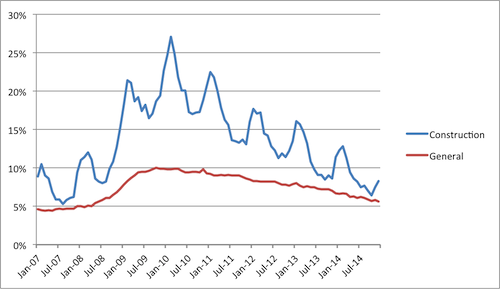Construction unemployment last year was at its lowest level in nearly seven years. At 8.9 percent, 2014 was the first time annual construction unemployment was below 10 percent since 2007, according to data collected by the Bureau of Labor Statistics.
Monthly construction unemployment also fell below seven percent -- to 6.4 percent in November-- for the first time since the beginning of the Great Recession.
 |
|
Construction unemployment is usually higher than overall unemployment, but during the Great Recession, it far outpaced the overall number. Construction unemployment has been closing in on the slowly falling overall rate, but the highly cyclical nature of construction employment --falling in the winter and rising as the weather improves – still leaves it is much higher than the general population for much of the year.
|
“I’m actually surprised the number is that high based on what I am seeing,” said Eighth District International Vice President Jerry Bellah, whose district encompasses Colorado, Idaho, Montana, Utah, and Wyoming. “It isn’t everywhere and the big population centers are definitely doing the best, but we are in a growth mode in the U.S. and Canada.”
Bellah said the outside numbers are even better and the concern there is manning the work.
“I feel a lot better than I did 18 months ago and now is the time to focus on organizing and training,” he said, “The No. 1 job is always making sure we capture the work while we grow.”
Bellah said he is seeing positive signs that locals are responding, with increasing membership across the brotherhood and a large jump in the number of apprentices.
While a vast improvement over 2009 (19 percent) and 2010 (20.6 percent), at 8.9 percent construction unemployment still lags far behind the general unemployment rate of 5.6 percent.
“The big change in this recovery is private money is just sitting on the sidelines,” Bellah said. “Companies are cash rich but not hiring and I think the offshoring of manufacturing has meant they don’t have to spend.”